MARIANI’SVirtual
Gourmet
September
16, 2012
NEWSLETTER
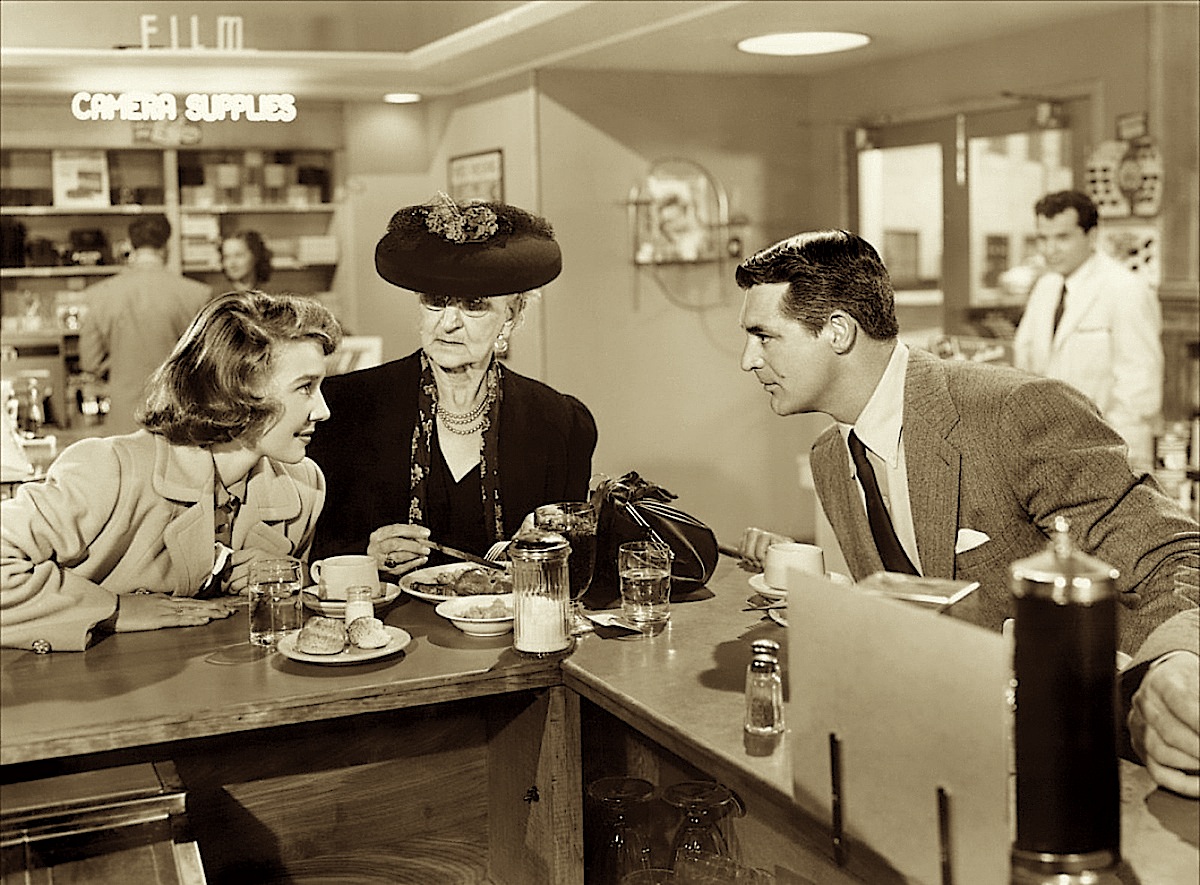
Betsy Drake and Cary
Grant in "Every Girl Should Get Married" (1948)
❖❖❖
WHY DO YOU GO OUT TO EAT AND WHAT
DO YOU EXPECT FROM A RESTAURANT?
by John Mariani
NEW YORK CORNER
Rouge Tomate
by John
Mariani
WHY DO YOU GO OUT TO EAT AND WHAT
DO YOU EXPECT FROM A RESTAURANT?
by John Mariani
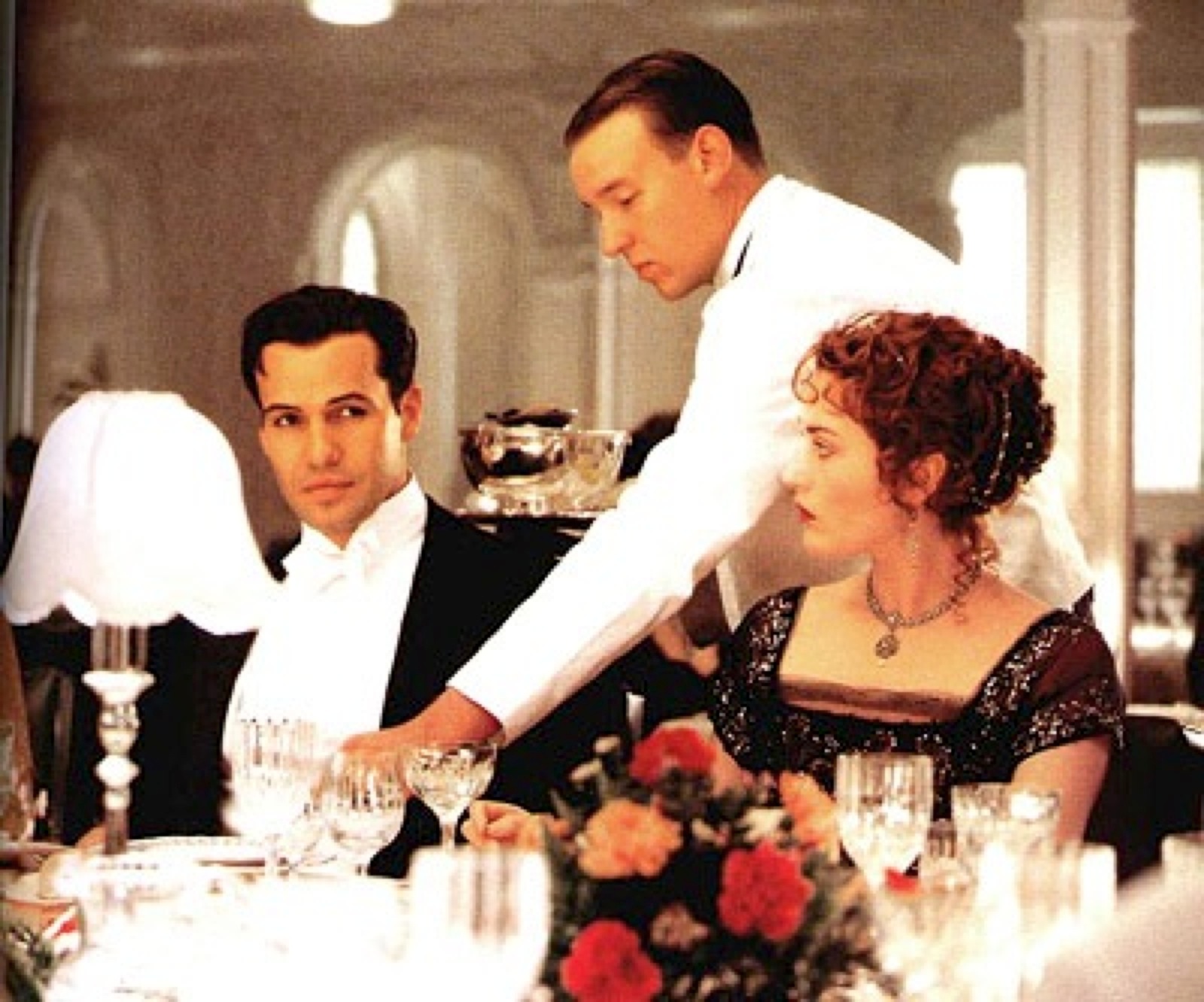
In last week's New York Times, two
articles seem to pose the same question: When you go
out to eat, what do you expect from a restaurant?
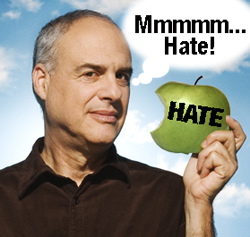 For columnist
Mark Bittman (below),
not much.
After lamenting his agonies dining at "four-star
white-tablecloth" restaurants, which he calls
"circuses without clowns or trapezes," with
"white-tooth phony" greetings, the "visit of the
wine guy," the "discussion of the menu," the
"waiting for the amuse-bouches," he ends his litany
of pain with, "If the food isn't mind-blowing,
what's the point?" To which the answer is, Duh?
For columnist
Mark Bittman (below),
not much.
After lamenting his agonies dining at "four-star
white-tablecloth" restaurants, which he calls
"circuses without clowns or trapezes," with
"white-tooth phony" greetings, the "visit of the
wine guy," the "discussion of the menu," the
"waiting for the amuse-bouches," he ends his litany
of pain with, "If the food isn't mind-blowing,
what's the point?" To which the answer is, Duh?
He then writes a paean
to "my place," a "Japanese hole in the wall" he
won't name that's "pleasant," populated "almost
exclusively by expat and visiting Japanese." He
calls it "ugly," with Formica tables, paper napkins,
and a cash register "wrapped in plastic to keep the
grease off the keys." The food is "quite good," the
gyoza "better than average." The servers "say hello
and send me to the back... The chef and cooks nod.
They cook their fine food. The servers bring it. I
eat it. A server comes and refills the water glass;
she might ask if I want more sake... Eventually I
pay the bill, without regret ($29 for two the other
day, and that was four dishes), and I go home happy,
satisfied and full. What more do you want, really?"
Again, Duh?
Turn the page, and
there's a story
by Susanne Craig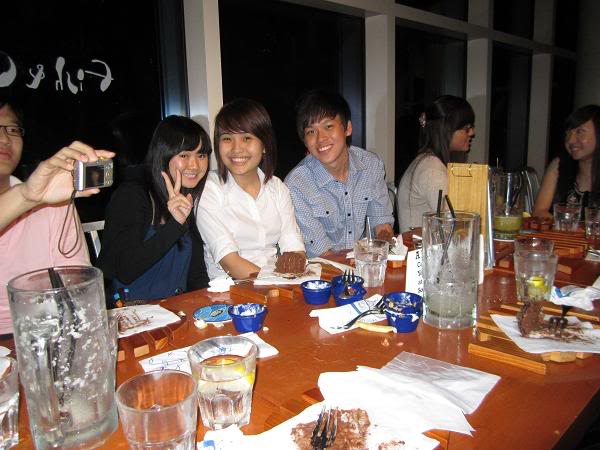 about "What Restaurants Know (About
You)," which details how white-tablecloth
restaurants keep lists on regular customers. It
cites Gramercy Tavern, which sends one regular only
the ends of the bread, as he prefers, and cooks
French fries for him even though they're not on the
menu.
about "What Restaurants Know (About
You)," which details how white-tablecloth
restaurants keep lists on regular customers. It
cites Gramercy Tavern, which sends one regular only
the ends of the bread, as he prefers, and cooks
French fries for him even though they're not on the
menu.
Craig cites OpenTable as
providing a service to restaurants whose owners want
to bend over backwards to please a customer, and she
alerts you to what it means if your name on the
guest list has a "PX" (person extraordinaire), "FOM"
(friend of the management), or LOL (for "little old
lady" who may need special help). And here's the
thing: In such restaurants, not having such an
abbreviation next to your name in no way
means you'll be treated any less cordially. That is
what they do.
I've written about such lists here
and applaud them for their professionalism and
courtesy, based on two centuries of adapting service
to an American hospitality — without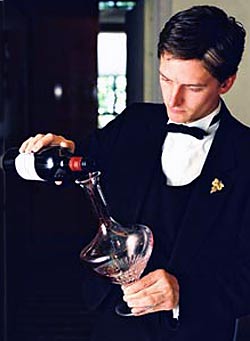 any "white-tooth phony grin." I love
it when the captain remembers my cocktail preference
and the "wine guy" makes a recommendation based on
my choices on prior visits. When people asked James
Beard what his favorite restaurant was, he would
always reply, "Why, the one where I'm treated best!"
any "white-tooth phony grin." I love
it when the captain remembers my cocktail preference
and the "wine guy" makes a recommendation based on
my choices on prior visits. When people asked James
Beard what his favorite restaurant was, he would
always reply, "Why, the one where I'm treated best!"
Despite Bittman's love of eating
in the back rooms of ugly holes-in-the-wall with
paper napkins, going out to a restaurant is so much
more than just eating some "quite good food."
Assuming, of course, the food at the high-end
restaurants is worth $100 or more per person, the
reason for patronizing them surely begins with a
sense of delight, an appreciation of what might be
millions of dollars spent to provide a beautiful
design, comfortable chairs, good lighting, and a
state-of-the-art kitchen capable of turning out amuses
and three-course meals for 150 people, and don't
have to wrap their cash registers in plastic. 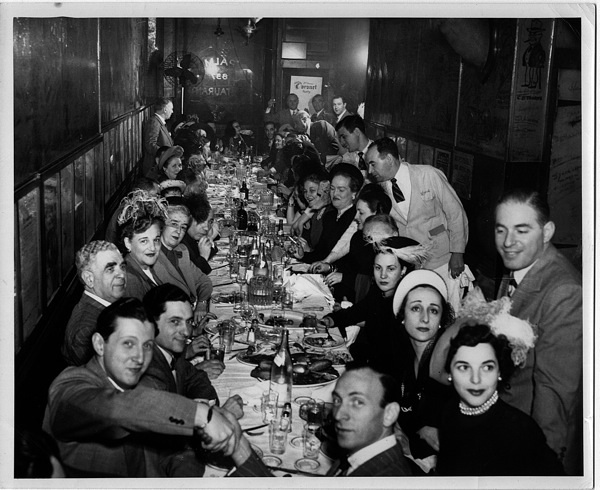 The atmosphere of a
classic steakhouse, the ebullience of a stylish
Italian restaurant, the comfort of a place where you
could bring your parents and kids, and the assurance
of a restaurant where, being a regular, you can take
a client with absolute confidence he will applaud
your good taste — these are but a few reasons that
99 percent of the people who can afford to eat out,
eat out.
The atmosphere of a
classic steakhouse, the ebullience of a stylish
Italian restaurant, the comfort of a place where you
could bring your parents and kids, and the assurance
of a restaurant where, being a regular, you can take
a client with absolute confidence he will applaud
your good taste — these are but a few reasons that
99 percent of the people who can afford to eat out,
eat out.
True, there seems to be a large
flock of foodies for whom the 90-minute wait for a
table, the rigid stools, the blasting music, and the
same $100 tab is preferable to a restaurant where
one is taken good care of and will dine extremely
well. It's a form of contrary snobbism where less is
more and more is suspect.
Do I have my secret little
holes-in-the-wall I like to go to? Of course — I'll
tell you their names if you like — pizzerias, sushi
bars, fried-seafood joints, noodle shops. I love 'em
all, but I don't confuse them with the rapture and
good feelings I find at fine-dining restaurants,
where they really do care that their guests
will have a unique evening out or one that is just
as wonderful as the last time.
❖❖❖
NEW YORK CORNER
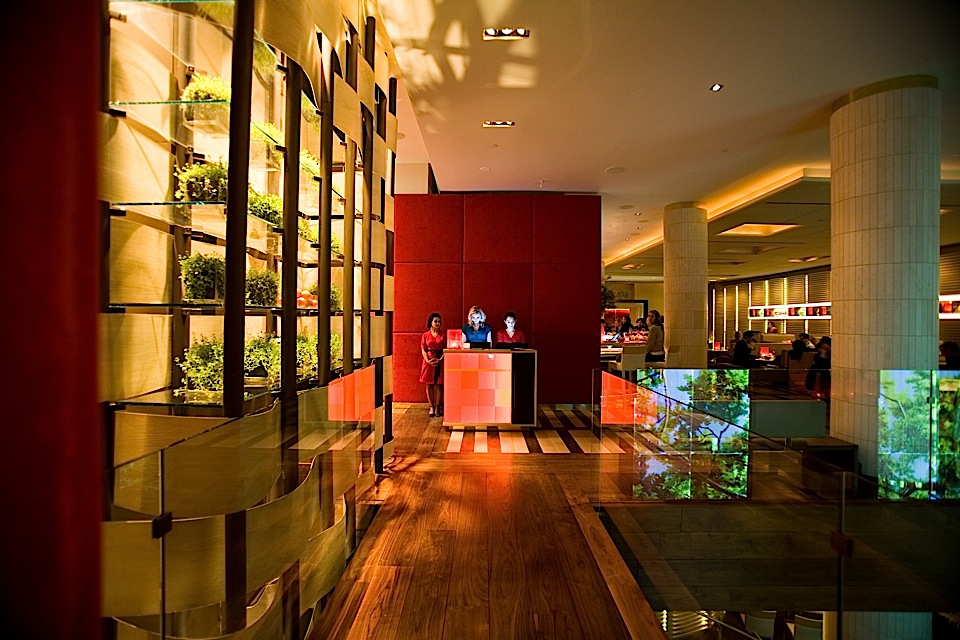 ROUGE TOMATE
ROUGE TOMATE10 East 60th Street (near Fifth Avenue)
646-237-8977
www.rougetomatenyc.com
When Rouge Tomate opened three
years ago, much was made about the restaurant's
commitment to SPE®, the acronym for Sanitas Per
Escam (Latin for Health Through Food), which also
stands for Sourcing, Preparing, and Enhancing, an
organization founded by Emmanuel Verstraeten, a
Belgium entrepreneur concerned about poor eating
habits and limited healthy dining options, in
his city and abroad.
Noble as that all is, a restaurant
succeeds or fails not by philosophy but by good taste
and pleasure, and NYC-born Chef Jeremy Bearman, here
from the start, along with nutritionist
Kristy Lambrou, has put far more emphasis
on those virtues than was evident at the beginning.
His résumé is certainly solid: db
bistro moderne in NYC, L’Atelier de Joël
Robuchon in Las Vegas, the Ritz Carlton’s Medici
Café and Terrace in Lake Las Vegas, 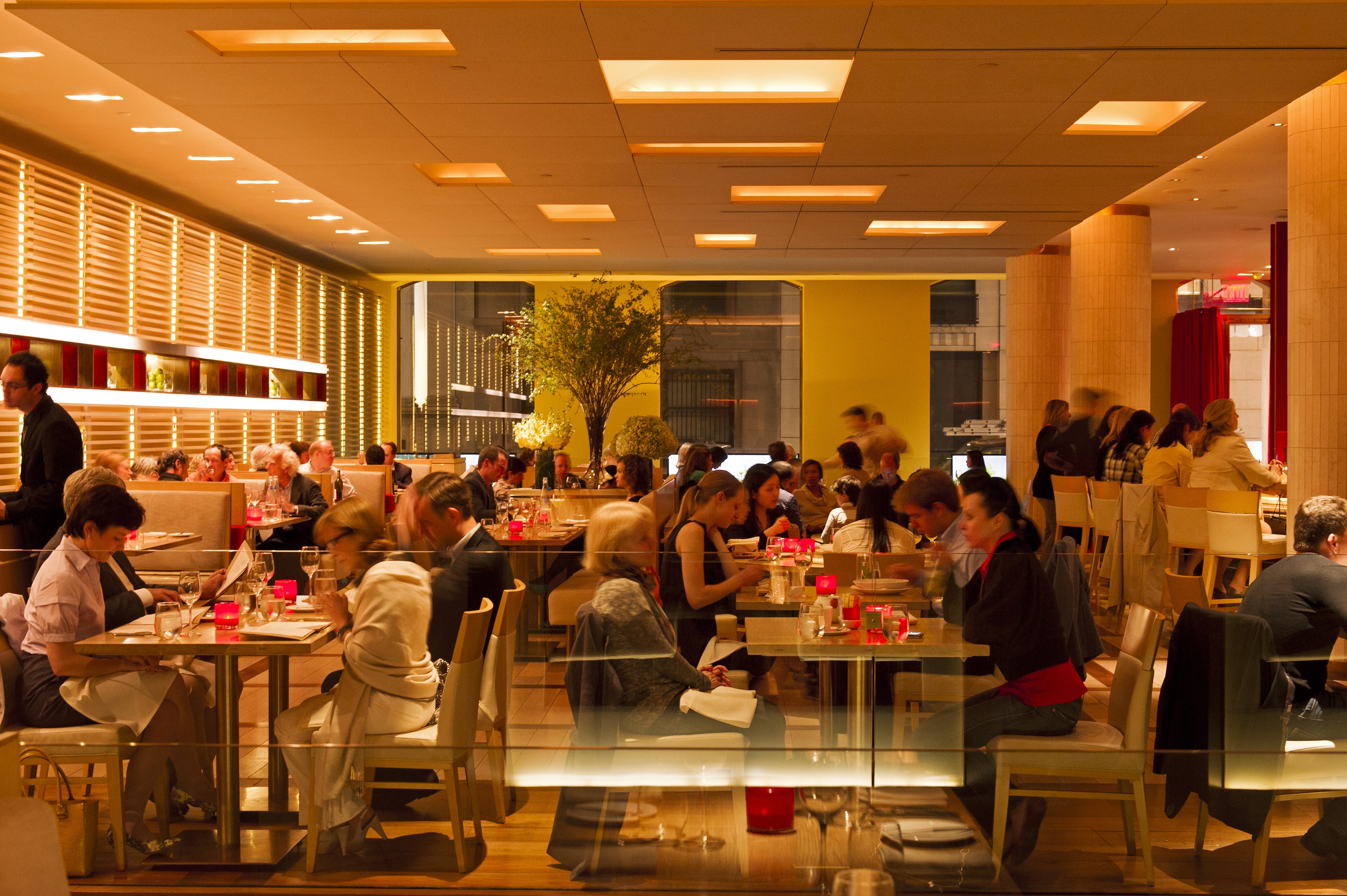 and Lark Creek Steak in San
Francisco.
and Lark Creek Steak in San
Francisco.
The restaurant is set on two
levels, with smart, high polish, a warm greeting,
wonderful light and color, and well-set, spacious
tables. The wine list is 200-plus labels strong.
One a recent Indian summer's eve,
we sat down to a lavish spread, allowing Bearman to
work his magic, and he began with what he calls
"toasts" (below),
a duo of oyster with plum mignonette, crispy ginger
and shiso;
and a corn and mild sea urchin panna cotta with
a lush lobster emulsion. A bright, flavorful gazpacho
followed with a touch of sweet watermelon and sherry
vinegar for acidic spark--which is very important in
this cuisine because there is not much fat in the
food.
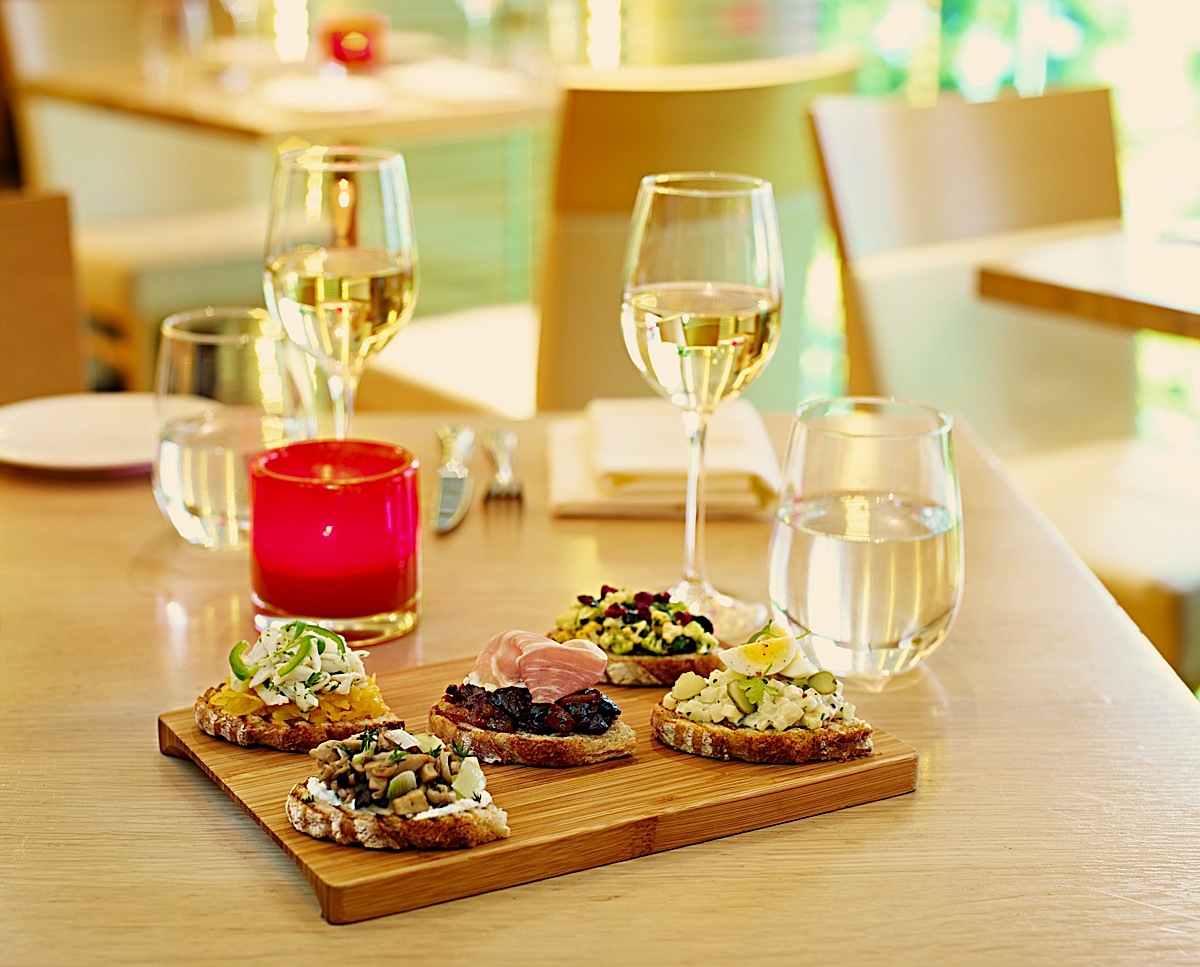 A series of
silky crudi
came next--Hawaiian walu with avocado, sugar snap
peas, radish and yuzu; corn and avocado with Maryland
crab, jalapeño, and cilantro; fluke
ceviche with ripe melon, cucumber, brisk Kaffir
lime and summer's mint; Arctic char with horseradish
yogurt, trout roe, dill and pumpernickel, and
more--all light, almost weightless, complex but
complementary in tastes and textures.
A series of
silky crudi
came next--Hawaiian walu with avocado, sugar snap
peas, radish and yuzu; corn and avocado with Maryland
crab, jalapeño, and cilantro; fluke
ceviche with ripe melon, cucumber, brisk Kaffir
lime and summer's mint; Arctic char with horseradish
yogurt, trout roe, dill and pumpernickel, and
more--all light, almost weightless, complex but
complementary in tastes and textures.
A fine Spanish octopus salad with
colorful eggplant caponata,
basil, tomato and smoked paprika vinaigrette
came with a Maine lobster salad with avocado, beans,
peach, and candied pecan with endive, all a little too
sweet for the lobster, saved only by the bitterness of
the endive. Cow’s milk ricotta gnudi 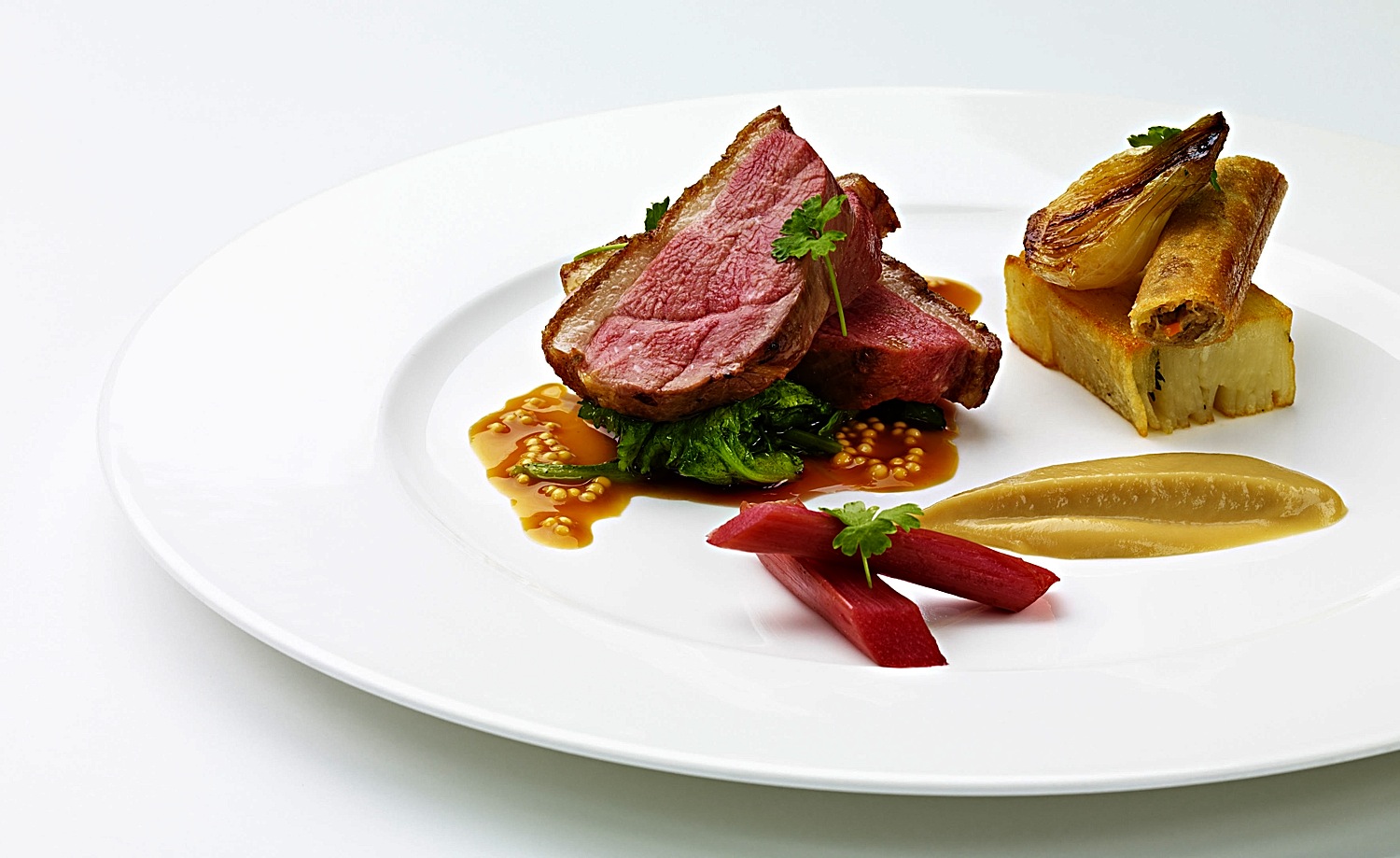 melted on the
tongue, with tomato, okra, sweet pepper, summer
squash, and basil.
melted on the
tongue, with tomato, okra, sweet pepper, summer
squash, and basil.
There were three of us that
night, and this was like a lot of food--before the
entrees--but we were far from full, happily so, since
what followed was cracked pepper garganelli with
veal sweetbread, chanterelle, corn, okra, tomato
and Shishito pepper, and a luscious duckling (right) with plum,
ginger, horseradish potato, Japanese eggplant and
honey-soy glaze that made this a contemporary,
considerably lighter, less greasy version of Peking
duck. Chicken was cooked juicy en Sous-Vide, with
polenta, Swiss chard, and peppers.
For dessert we had an array--yellow
peach, raspberry, pistachio and candied lemon sorbets,
a blueberry custard, chilled melon soup, and more, by
which time we were feeling very satisfied.
These are all exciting concepts and
Bearman delivers the flavor. It s a menu all of a
piece, and, though a vegetarian might feel blissful
here, I am happy that it contains duck and squab and
other fatted meats. What I'm not crazy about is the
meadow of micro-greens strewn everywhere, which have
little or no taste and just get stuck in one's teeth.
(I wonder what his micro-greens bill is each month?)
You may well find dishes like these
around NYC, but nowhere is there such a panoply on a
menu that is very devoted to doing what Bearman and
his partners believe in.
❖❖❖
 WHY NOT JUST EAT
ON
WHY NOT JUST EAT
ON
THE
SCIENTOLOGY SPACESHIP?
While in the Adriatic, Tom
Cruise demanded a Montenegro hotel clear
its dining room so he could eat alone. When refused,
he got another restaurant to deliver to his yacht.
 LEAN AND VERY VERY
MEAN
LEAN AND VERY VERY
MEANRecipes in the new cookbook
The Need to Feed, A Hedonist's Guide by Lydia Lunch.
-Kill Billy with Beef Chipotle Marinade
-You'll Thank Me for Kicking Your Ass Curry
-Eat My Peach Before It Crumbles
-Sacrificial Lamb
-I Said Jerk That Chicken!
Any of John Mariani's
books below may be ordered from amazon.com.
 |
My latest book, which just won the prize for best book from International Gourmand, written with Jim Heimann and Steven Heller, Menu Design in America, 1850-1985 (Taschen Books), has just appeared, with nearly 1,000 beautiful, historic, hilarious, sometimes shocking menus dating back to before the Civil War and going through the Gilded Age, the Jazz Age, the Depression, the nightclub era of the 1930s and 1940s, the Space Age era, and the age when menus were a form of advertising in innovative explosions of color and modern design. The book is a chronicle of changing tastes and mores and says as much about America as about its food and drink.
“Luxuriating vicariously in the pleasures of this book. . . you can’t help but become hungry. . .for the food of course, but also for something more: the bygone days of our country’s splendidly rich and complex past. Epicureans of both good food and artful design will do well to make it their coffee table’s main course.”—Chip Kidd, Wall Street Journal.
“[The menus] reflect the amazing craftsmanship that many restaurants applied to their bills of fare, and suggest that today’s restaurateurs could learn a lot from their predecessors.”—Rebecca Marx, The Village Voice. |
"Eating Italian will never be the same after reading John Mariani's entertaining and savory gastronomical history of the cuisine of Italy and how it won over appetites worldwide. . . . This book is such a tasteful narrative that it will literally make you hungry for Italian food and arouse your appetite for gastronomical history."--Don Oldenburg, USA Today. "Italian
restaurants--some good, some glitzy--far
outnumber their French rivals. Many of
these establishments are zestfully described
in How Italian Food Conquered the World, an
entertaining and fact-filled chronicle by
food-and-wine correspondent John F.
Mariani."--Aram Bakshian Jr., Wall Street
Journal.
"Equal parts
history, sociology, gastronomy, and just
plain fun, How Italian Food Conquered the
World tells the captivating and delicious
story of the (let's face it) everybody's
favorite cuisine with clarity, verve and
more than one surprise."--Colman Andrews,
editorial director of The Daily
Meal.com. "A fantastic and fascinating
read, covering everything from the influence
of Venice's spice trade to the impact of
Italian immigrants in America and the
evolution of alta cucina. This book will
serve as a terrific resource to anyone
interested in the real story of Italian
food."--Mary Ann Esposito, host of PBS-TV's
Ciao
Italia. "John Mariani has written the
definitive history of how Italians won their
way into our hearts, minds, and
stomachs. It's a story of pleasure over
pomp and taste over technique."--Danny Meyer,
owner of NYC restaurants Union Square Cafe,
Gotham Bar & Grill, The Modern, and
Maialino.
|
 |
 |
 |
 |
 |
 |
 |
 |
 Everett Potter's Travel Report:
Everett Potter's Travel Report: 
 Eating Las Vegas
is the new on-line site for Virtual Gourmet
contributor John A. Curtas., who since 1995
has been commenting on the Las Vegas food
scene and reviewing restaurants for Nevada
Public Radio. He is also the
restaurant critic for KLAS TV, Channel 8 in
Las Vegas, and his past reviews can be
accessed at KNPR.org.
Click on the logo below to go directly to
his site.
Eating Las Vegas
is the new on-line site for Virtual Gourmet
contributor John A. Curtas., who since 1995
has been commenting on the Las Vegas food
scene and reviewing restaurants for Nevada
Public Radio. He is also the
restaurant critic for KLAS TV, Channel 8 in
Las Vegas, and his past reviews can be
accessed at KNPR.org.
Click on the logo below to go directly to
his site.

Tennis Resorts Online: A Critical Guide to the World's Best Tennis Resorts and Tennis Camps, published by ROGER COX, who has spent more than two decades writing about tennis travel, including a 17-year stretch for Tennis magazine. He has also written for Arthur Frommer's Budget Travel, New York Magazine, Travel & Leisure, Esquire, Money, USTA Magazine, Men's Journal, and The Robb Report. He has authored two books-The World's Best Tennis Vacations (Stephen Greene Press/Viking Penguin, 1990) and The Best Places to Stay in the Rockies (Houghton Mifflin, 1992 & 1994), and the Melbourne (Australia) chapter to the Wall Street Journal Business Guide to Cities of the Pacific Rim (Fodor's Travel Guides, 1991).


MARIANI'S VIRTUAL GOURMET
NEWSLETTER is published weekly. Editor/Publisher: John
Mariani.
Contributing Writers: Christopher Mariani, Robert Mariani,
John A. Curtas, Edward Brivio, Mort Hochstein,
Suzanne Wright, and Brian Freedman. Contributing
Photographers: Galina Stepanoff-Dargery,
Bobby Pirillo. Technical Advisor: Gerry McLoughlin.
© copyright John Mariani 2012
